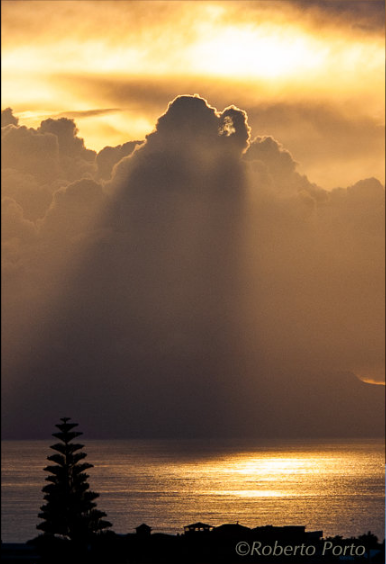Cloud Shadows
Cloud Shadows: A Fascinating Atmospheric Phenomenon
Cloud shadows are a captivating atmospheric optics phenomenon that occurs when sunlight is partially blocked by clouds, creating areas of shadow on the Earth's surface. These shadows add depth and dimension to the landscape, enhancing the visual experience of the sky. In this article, we will delve deeper into the intricacies of cloud shadows and explore their mesmerizing effects.
The Formation of Cloud Shadows
Cloud shadows are formed when sunlight interacts with clouds, causing variations in the intensity of light reaching the ground. As the sun's rays pass through the gaps between clouds, they cast shadows on the Earth's surface. These shadows can appear as dark patches or streaks, contrasting with the illuminated areas around them.
Rays and Shadows: A Spectacular Sight
One remarkable aspect of cloud shadows is the presence of rays. Rays are revealed as gaps between the shadows, creating a stunning visual effect. When captured through a long lens, these rays can even appear parallel, adding an extra layer of intrigue to the scene. The interplay between light and shadow creates a captivating display that captivates both photographers and observers alike.
Exploring the Source: Cloud Shadows at Their Origin
To truly appreciate cloud shadows, it is essential to observe them at their source. One example of this can be witnessed on the Canary Islands, specifically La Gomera and Tenerife. As clouds cluster over La Gomera, their shadows darken the atmosphere and leave their footprint on the ocean's surface. This phenomenon offers a unique perspective on the formation and behavior of cloud shadows.
The Influence of Topography
The topography of an area plays a significant role in the formation of cloud shadows. In mountainous regions like the Canary Islands, convection from warmer land combined with the cooling of moisture-laden air during its passage over the terrain contributes to the frequent cloud cover. This interaction between land and air creates the ideal conditions for the development of cloud shadows, offering a captivating display for onlookers.
The Canary Islands: A Perfect Stage for Cloud Shadows
The Canary Islands, a chain of volcanic islands located westwards from Africa, provide an ideal setting to observe cloud shadows. With their frequent cloud cover amidst an otherwise cloud-free ocean, these islands offer a unique vantage point to witness the interplay between sunlight, clouds, and shadow. Additionally, the presence of world-renowned telescopes on La Palma further adds to the allure of this location for both scientists and sky enthusiasts.
The Formation of the Canary Islands
The formation of the Canary Islands is a topic of geological fascination. These volcanic islands, with the youngest ones located towards the west, were formed as a result of tectonic activity. The prevailing theory suggests that the African tectonic plate slowly drifted over a plume of hot magma rising in the underlying mantle. This movement allowed the lava to break through and form a succession of volcanic islands. However, the actual process is likely more complex and continues to be an area of scientific study.
Conclusion
Cloud shadows are a captivating atmospheric phenomenon that adds depth and visual interest to the sky. The interplay between sunlight, clouds, and shadows creates mesmerizing displays, often accompanied by the presence of rays. Observing cloud shadows at their source, such as on the Canary Islands, offers a unique perspective on their formation and behavior. The topography of an area, like mountainous terrain, plays a crucial role in shaping the occurrence of cloud shadows. The Canary Islands, with their frequent cloud cover and volcanic origins, provide an ideal stage to witness this phenomenon. By exploring the intricacies of cloud shadows, we gain a deeper understanding and appreciation for the beauty and complexity of our atmosphere.

Rays Shadows
Roberto Porto imaged these near sunset rays and shadows from clouds clustered over the
Canaries island of La Gomera. He was some 25 miles away on the adjacent island of Tenerife.
Here we see cloud shadows at their source, their darkening of the atmosphere and (below)
their footprint on the ocean.
"Rays" are revealed as gaps between the shadows. In this long lens shot we even start to
believe that they are parallel!


A tube of dark air reaches down to the ocean
Below: Viewed from Tenerife, the islands of La Gomera (on the horizon at centre left) and La Palma (right) are revealed by their frequent cloud cover in an otherwise cloud-free ocean.
Convection from the warmer land combined with cooling of moisture laden air during its passage over the mountainous terrain are responsible. The nearby clouds at right are over Tenerife itself.
La Palma houses some of the world's great telescopes.
<iframe width="853" height="480" src="https://www.youtube.com/embed/93Ujt36IUHc" title="El cielo afortunado 2020" frameborder="0" allow="accelerometer; autoplay; clipboard-write; encrypted-media; gyroscope; picture-in-picture; web-share" allowfullscreen></iframe>

The Canaries are a chain of still active volcanic islands dotted westwards from Africa. The
westward ones are the youngest. A popular simple model of their formation is that the African tectonic plate drifted slowly over a plume of hot magma rising in the underlying
mantle. The lava broke through to form a succession of volcanic islands. The reality is
possibly rather more complicated.

Note: this article has been automatically converted from the old site and may not appear as intended. You can find the original article here.
Reference Atmospheric Optics
If you use any of the definitions, information, or data presented on Atmospheric Optics, please copy the link or reference below to properly credit us as the reference source. Thank you!
-
<a href="https://atoptics.co.uk/blog/cloud-shadows-2/">Cloud Shadows </a>
-
"Cloud Shadows ". Atmospheric Optics. Accessed on December 25, 2024. https://atoptics.co.uk/blog/cloud-shadows-2/.
-
"Cloud Shadows ". Atmospheric Optics, https://atoptics.co.uk/blog/cloud-shadows-2/. Accessed 25 December, 2024
-
Cloud Shadows . Atmospheric Optics. Retrieved from https://atoptics.co.uk/blog/cloud-shadows-2/.